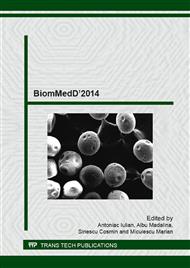p.151
p.155
p.161
p.165
p.171
p.177
p.183
p.191
p.197
Simulation of Bone Mechanical Adaptation in a 3D Model of the Proximal Femur Using the Stanford Strain Energy Density Approach
Abstract:
The mathematical theories of bone mechanical adaptation are based on a nonlinear ordinary differential equation which governs the evolution of bone density with respect to the applied loads. If the density distribution achieved within a certain bone model resembles the expected distribution observed in the real bone, then the mathematical theory is usually thought to be suited for such simulations. As test problem, it was extensively used the coronal section of the proximal femur. This section inspired the very creation of the mathematical models following Wolff’s observations regarding trabecular architecture. However, the lack of quantitative data when using the bi dimensional femur model prevents the quantitative validation of the adaptation mathematical models. Using computed tomography is now possible to reconstruct the three dimensional geometry of bones and also to estimate the apparent density based on correlations with the Hounsfield units. This method was already used to quantitatively validate the simulation of bone remodeling into different bones and proved to be efficient. The paper presents the apparent density distributions achieved into the 3D model of the proximal femur by coupling the finite element method with the Stanford bone adaptation equation. The densities obtained in this manner are compared by those determined from the tomographic data of the same bone. The purpose relies on establishing whether the three dimensional end proximity of the femur bone can be used for quantitative validation of remodeling simulations.
Info:
Periodical:
Pages:
171-176
Citation:
Online since:
March 2015
Authors:
Price:
Сopyright:
© 2015 Trans Tech Publications Ltd. All Rights Reserved
Share:
Citation:


